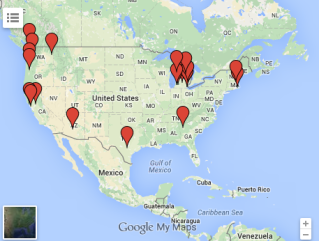In a major, major win for business groups and transit advocates, Phoenix voters approved a 0.7-cent sales tax increase that will go toward funding a mix of rail and road projects around the region. The seemingly controversial ballot measure (it’s a tax increase, after all!), garnered a whopping 55 percent of the vote. Brenna Goth of the Arizona Republic has more:
The city’s 0.4 percent sales tax for transit will increase to 0.7 percent for transportation, beginning Jan. 1 and lasting 35 years. The sales tax is the foundation of a $31.5 billion plan that will be funded by a variety of sources including federal grants and fares.
[…]
The success of Prop. 104 is a victory for Phoenix leaders promoting the tax since the City Council approved the measure in March. Mayor Greg Stanton, who formed a citizens committee last year to envision Phoenix’s transportation future, spent much of the summer campaigning for the measure over his own bid for re-election.
Supporters of MovePHX, the campaign in favor of the plan, crowded DeSoto Central Market to watch early results. They joined Stanton’s election night party at the downtown spot near the light rail.
Stanton claimed victory for Prop. 104 after early results were released, calling the infrastructure investment a historic moment for Phoenix.
“This is a great night for the future of the city of Phoenix,” Stanton said.
More than half of the Prop. 104 plan’s funding will go to maintaining and improving bus service throughout the city. Less than a third will pay for running current light rail service and building new routes.
About 7 percent will fund street improvements such as repaving roads, constructing new streets and adding sidewalks and bike lanes. The last 10 percent will pay for debt service and an operating reserve.
The most contested aspect of the proposal was the planned tripling of light rail miles in the system. Potential new routes will connect from the current line to reach destinations such as Paradise Valley Mall, south Phoenix, 79th Avenue, Grand Canyon University and Metrocenter Mall.
Monica Keyes, 33, dropped off her ballot at the Memorial Presbyterian Church off East Thomas Road on her way to work Tuesday.
She said she voted in favor of Prop. 104. “I use public transportation and I think it’s great that it’d expand,” she said. “I think it makes it a better place to live in our community.”
Prop. 104 won support from the majority of the City Council as well as business, health and education leaders in the run up to Tuesday’s election.
Developers who are expected to benefit also weighed in their support (courtesy Mike Sunnucks of the Phoenix Business Journal):
Tim Sprague says he has some selfish reasons for celebrating Phoenix voters’ approval of Proposition 104 Tuesday night.
Prop. 104 is the city’s newly approved 0.7-cent sales tax that will be earmarked for transportation including 42 miles of new light rail lines as well as street improvements and express and night buses.
Sprague is an infill developer of the condominiums on Portland Street and apartments on Grand Avenue. He’s also been part of urban developments in Portland.
Sprague hopes approval of Prop. 104 will help convince his four urban-minded adult children to move back to Phoenix. He said approval of the measure will help further infill and urban developments in a traditionally suburban Maricopa County.
While I don’t know the entire story, it appears that the pro-Prop 104 folks were both (1) extremely organized and (2) weren’t afraid at doing some good ol’ fashioned GOTV. Building support around ballot initiatives is never easy. This is especially true for ballot initiatives that call for a tax increase. It will be interesting to see the post-election dissection to see what was done here that could inform other local transportation ballot campaigns around the country.
 Given the announcement yesterday about four major bond proposals in Harris County, the Houston Chronicle’s
Given the announcement yesterday about four major bond proposals in Harris County, the Houston Chronicle’s 

 Last week I posted story summarizing
Last week I posted story summarizing  Rise and shine, it’s Monday morning. Here’s a recap of the latest going on in the world of better infrastructure and initiatives around the country to fund more of it.
Rise and shine, it’s Monday morning. Here’s a recap of the latest going on in the world of better infrastructure and initiatives around the country to fund more of it. The Center for Transportation Excellence (CTE) is
The Center for Transportation Excellence (CTE) is